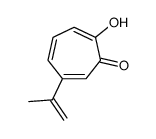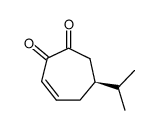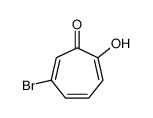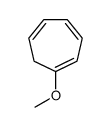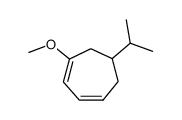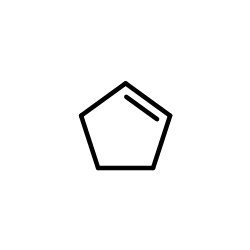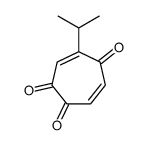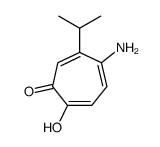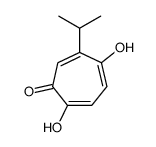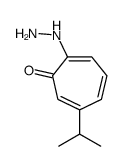499-44-5
| Name | β-thujaplicin |
|---|---|
| Synonyms |
Isopropyltropolone
2-Hydroxy-6-(propan-2-yl)cyclohepta-2,4,6-trien-1-one B-THUJAPLICIN 2,4,6-cycloheptatrien-1-one, 2-hydroxy-6-(1-methylethyl)- 2-Hydroxy-6-(propan-2-yl)cyclohepta-2,4,6-trien-1-on beta-thujaplicin 4-ISOPROPYLTROPOLONE MFCD00040180 2-Hydroxy-4-isopropylcyclohepta-2,4,6-trien-1-one 2,4,6-Cycloheptatrien-1-one, 2-hydroxy-4-(1-methylethyl)- β-Thujaplicine EINECS 207-880-7 Hinokitiol β-Thujaplicin Hinokitol 2-Hydroxy-4-isopropyl-2,4,6-cycloheptatrien-1-one 2-hydroxy-4-(1-methylethyl)-2,4,6-cycloheptatrien-1-one |
| Description | Hinokitiol is a component of essential oils isolated from Chymacyparis obtusa, reduces Nrf2 expression, and decreases DNMT1 and UHRF1 mRNA and protein expression, with anti-infective, anti-oxidative, and anti-tumor activities. |
|---|---|
| Related Catalog | |
| Target |
DNMT1 Nrf2 |
| In Vitro | In U87MG and T98G glioma cell lines, hinokitiol demonstrates a dose-dependent decrease in viability, with IC50 values of 316.5 ± 35.5 and 152.5 ± 25.3 µM, respectively. Hinokitiol represses ALDH activity and self-renewal ability in glioma stem cells, and inhibits in vitro oncogenicity. Hinokitiol also reduces Nrf2 expression in glioma stem cells in a dose-dependent manner[1]. Hinokitiol (0-100 μM) inhibits colon cancer cell growth in a dose- and time-dependent manner. Hinokitiol (5, 10 μM) decreases DNMT1 and UHRF1 mRNA and protein expression, and increases TET1 expression via enhancement of 5hmC level in HCT-116 cells. Furthermore, hinokitiol reduces methylation status and restores mRNA expression of MGMT, CHST10, and BTG4 genes[2]. |
| Cell Assay | U87MG and T98G glioma cells are cultured in Dulbecco's modified Eagle's medium with Ham's F12 medium (DMEM/F-12) containing 10% fetal bovine serum. Cell viability is determined using MTT to evaluate the cytotoxicity of hinokitiol. Cells are seeded in 24-well plates (1×105 cells/well) in the presence of various concentration of hinokitiol or vehicle at 37°C for 24 h followed by incubation with MTT reagent. The blue formazan crystals of viable cells are dissolved in DMSO and then evaluated spectrophotometrically at 570 nm. DMSO-treated group is set as 100%, and data are presented as percentage of DMSO control. IC50 values are calculated by the GraFit software. |
| References |
| Density | 1.1±0.1 g/cm3 |
|---|---|
| Boiling Point | 303.4±35.0 °C at 760 mmHg |
| Melting Point | 50-52 °C(lit.) |
| Molecular Formula | C10H12O2 |
| Molecular Weight | 164.201 |
| Flash Point | 128.1±18.5 °C |
| Exact Mass | 164.083725 |
| PSA | 37.30000 |
| LogP | 1.89 |
| Vapour Pressure | 0.0±1.4 mmHg at 25°C |
| Index of Refraction | 1.554 |
CHEMICAL IDENTIFICATION
HEALTH HAZARD DATAACUTE TOXICITY DATA
|
| Symbol |

GHS07 |
|---|---|
| Signal Word | Warning |
| Hazard Statements | H302 |
| Personal Protective Equipment | dust mask type N95 (US);Eyeshields;Gloves |
| Hazard Codes | Xn:Harmful; |
| Risk Phrases | R22 |
| Safety Phrases | S36 |
| RIDADR | NONH for all modes of transport |
| WGK Germany | 3 |
| RTECS | GU4200000 |
| HS Code | 2914400090 |
| Precursor 8 | |
|---|---|
| DownStream 9 | |
| HS Code | 2914400090 |
|---|---|
| Summary | 2914400090 other ketone-alcohols and ketone-aldehydes。Supervision conditions:None。VAT:17.0%。Tax rebate rate:9.0%。MFN tariff:5.5%。General tariff:30.0% |


